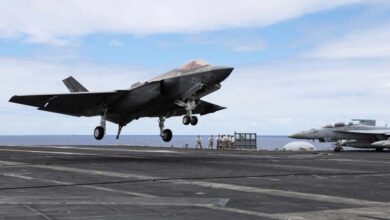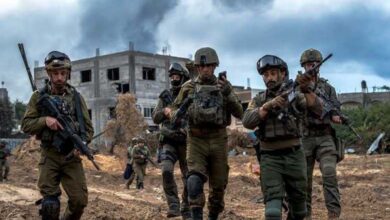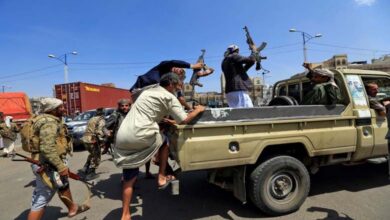Russia’s Summer of Fury: How Will Putin Respond to Spider Web?

As soon as Ukraine launched Operation “Spider Web” deep inside Russian territory—one of its most daring and complex attacks—it became clear that Kyiv had opened the door to a “heavy summer.”
Despite managing to breach Russian defenses and deliver targeted strikes on infrastructure and command centers, Moscow now appears poised for a new phase of escalation. Determined to flip the script, it is preparing to push towards Ukraine’s heartland, using the “summer foliage” as natural cover for its advancing forces, according to The Telegraph.
-
Russian Invisibility Cloaks: Optical Illusion or Deadly Trap?
-
Putin Invites Arab Leaders to Participate in the First Russian-Arab Summit in October
A Likely Russian Escalation?
Ukrainian President Volodymyr Zelensky says Russia is preparing not for peace but for escalation. “There’s ample evidence that they are preparing new offensive operations,” he stated last week. Some analysts believe the offensive has already begun.
Ben Barry, a land warfare expert at the International Institute for Strategic Studies in London, notes that each summer in Ukraine’s ongoing war tends to bring intensified fighting.
Ukraine’s failed counteroffensive in 2023 and its unsuccessful incursion into Russia’s Kursk region in 2024 both took place in warmer months. Around this time last year, Moscow also launched a surprise attack in Ukraine’s Kharkiv region. Analysts believe Russia is once again attempting to break the deadlock.
-
Largest Attack in Three Years: 337 Ukrainian Drones Fall into the Russian Trap
-
A New Russian Tactic to Capture Ukrainian Drones
Over the past year, Russian forces have made gradual, though limited, gains—seizing about 1,500 square miles of Ukrainian territory by 2024, roughly 0.7% of the country’s total area.
In May, Russian forces advanced at their fastest pace since the previous November, capturing an average of 5.5 square miles per day—double April’s rate—according to Ukraine’s Deep State intelligence project.
Russia’s current focus is on Donbas, a historically Russian-speaking region central to the Kremlin’s territorial ambitions. Most of the Donbas is already under Russian control: 99% of Luhansk and about 77% of Donetsk.
The goal now is likely to seize the remaining urban and industrial strongholds in Donetsk. Analysts believe progress is likely, though few expect Russia to capture the entire region.
-
“Strategic ‘Toretsk’ in Russian Hands… Ukraine Faces Supply Line Crisis”
-
The “Orechnik” Surprise: The Russian “Terrifying” Missile Pulses with a Western Heart
How Will Russia Strike Back?
A large-scale tank offensive is unlikely. In the drone-dominated battlefield, such tactics are outdated, says Polish military analyst Konrad Muzyka. “The battlefield is clear: any widespread use of armor will be swiftly destroyed. Russians have shifted to focused assaults by small units of 3–5 men. Company-sized attacks (50–100 men) have virtually disappeared.”
Instead, Russian forces advance using motorcycles or buggies, and sometimes deliver supplies via mules. Even so, a decisive breakthrough is improbable, though Putin seems confident about achieving significant progress on multiple fronts.
-
“Osama Bin Zelensky”: A New Russian Nickname for the Ukrainian President
-
Russian Women Sending Their Husbands to Fight in Ukraine: What’s the Secret?
Donbas in the Crosshairs
Fighting has intensified on the Sumy front in northeastern Ukraine. After being pushed out of Kursk in March, Russian forces are now applying pressure in Sumy, aiming to establish a buffer zone to prevent future Ukrainian incursions.
Ukrainian intelligence reports some 125,000 Russian troops amassed along the Sumy and Kharkiv borders. Four border villages have fallen to Russian forces in the past ten days.
However, Sumy and Kharkiv are unlikely to be Putin’s main objectives. These offensives may be designed to distract Ukrainian forces from the real target: Donetsk.
-
Ukraine War: Russian Advance Shifts the Balance of Power and a Target Bank Ahead of Winter
-
CNN reveals details of the deadliest Russian attack on Ukraine since the start of the war
Ukraine’s withdrawal from Kursk was meant to reinforce depleted units in Donetsk, but the need to defend Sumy disrupted these plans. As a result, Russian forces breached defenses between Pokrovsk and Toretsk, increasing pressure on Kostiantynivka — a vital logistics hub.
Losing Kostiantynivka would complicate resupply efforts and place Kramatorsk — the largest unoccupied city in Donetsk — within range of Russian rocket artillery.
-
The White Whale: “Russian Spy” or Recreational Therapist?
-
“The Russian Hell” shakes Ukraine… Learn about the “Doomsday” bomb
Russia’s Tactical Advantages
Russia now holds the battlefield advantage, enabling its commanders to dictate where to strike. This superiority stems largely from greater manpower and technological advancements in offensive and defensive weaponry.
Its most notable progress lies in drone production. Since 2022, Moscow has imported Iranian-made Shahed drones and now produces its own version, Geran-2, through a £1 billion deal.
With factory workers — many women recruited from Africa — production has surged from 300 drones/month to 100/day. Zelensky claims Russia aims to triple this figure.
-
“The Deadly Lake”.. The Ghost of the Cold War Haunts a Russian Region
-
Targeting the Kremlin… Ukraine Fails in Its Counterattack on the Russian Capital
Russia also upgraded the Geran-2 engine, enabling higher altitudes, greater payloads, and more difficult interceptions.
Since late May, Russia has launched frequent drone, cruise missile, and ballistic missile attacks on Ukrainian cities, including Kyiv, killing dozens of civilians.
Ukraine hopes its “Spider Web” drone operation will help mitigate these attacks. In response, Russia is combining drone, cruise, and ballistic missile strikes — using varied speeds and flight paths — to overwhelm and confuse Ukrainian air defenses.
-
What are the implications and goals of the Gulf-Russian summit?
-
Ukraine Attacks Occupied Melitopol, Russian Side Says Two Killed
Muzyka says Russia’s widespread use of fiber-optic FPV drones allows them to strike fortified positions more effectively. These tethered drones are hard to detect and neutralize, and have disrupted logistics and forced Ukrainian withdrawals in previous failed incursions like Kursk.
Manpower Matters
Russia’s other key advantage is its ability to recruit faster than Ukraine. High financial incentives — sign-on bonuses up to £16,000 and potential salaries of £48,000/year — have attracted thousands. Russian troop numbers in Ukraine rose from 500,000 to 620,000 in one year, according to Kyiv’s National Institute for Strategic Studies.
-
Ukrainian village bombed… Russian separatists and Kyiv blame each other for cease-fire violations
-
Thousands demonstrate in Ukraine against possible Russian invasion
Ukraine’s Challenges
On the other hand, Ukraine is facing immense challenges. After resisting Western pressure to conscript men under the age of 25 — a move that would be highly unpopular — the Zelensky government instead launched the “18–24 Campaign,” offering financial incentives and interest-free mortgage loans to attract young volunteers.
According to a source close to the General Staff, the strategy has proven somewhat effective. However, many analysts point out that recruitment levels still fall far short of the target.
-
Crisis in Ukraine: Scenario and date of a possible Russian invasion
-
Turkey is testing Russian-made S-400 defense systems
There is also growing concern about future supplies of Western weapons. Donald Trump is unlikely to resume significant support, even if he loses patience with Putin. And the chances of replicating the Biden administration’s generosity — which saw the U.S. provide Kyiv with nearly £50 billion in military aid alone — appear very slim.












